img#mv-trellis-img-2::before{padding-top:82.022471910112%; }img#mv-trellis-img-2{display:block;}img#mv-trellis-img-3::before{padding-top:83.960396039604%; }img#mv-trellis-img-3{display:block;}img#mv-trellis-img-4::before{padding-top:68.852459016393%; }img#mv-trellis-img-4{display:block;}img#mv-trellis-img-5::before{padding-top:71%; }img#mv-trellis-img-Arabians are one of the oldest and most beautiful horse breeds in the world. Native to the Arabian Peninsula, they are famous for their unique dished heads, high tail carriage, and remarkable intelligence.
Arabians are also one of only three hot-blooded horse breeds in the world, characterized by speed, stamina, and a spirited nature.
Over the course of history, Arabian Horses have reached every corner of the world. Due to their beauty and versatility, they have become one of the most popular horse breeds on the planet. Arabians have even made it into Hollywood and were featured in famous movies such as The Black Stallion.
Arabian Horses are typically lightweight, with lean muscles and tendons like steel made for endurance. They are relatively small horses, standing only 14.1 to 15.1 hands. Today, the breed is most often used as a show, sport, and pleasure riding horse.
Here are thirteen fascinating facts about Arabian Horses:
1. Arabians Are One of the Oldest Horse Breeds in the World
The available archeological evidence suggests that the history of Arabian Horses dates back to at least 4,500 years ago. While the breed’s exact origins are obscure, modern Arabians are thought to be the descendants of the ancient “Proto-Arabian”.
Horses resembling the typical Arabian appear on numerous inscriptions and rock paintings of the Arabian Peninsula from 3,500 years ago. They were also featured in the artwork of Ancient Egypt dating back to the 16th century BC.
These and other pieces of evidence prove that Arabian Horses have been the loyal partners of humans for thousands of years.
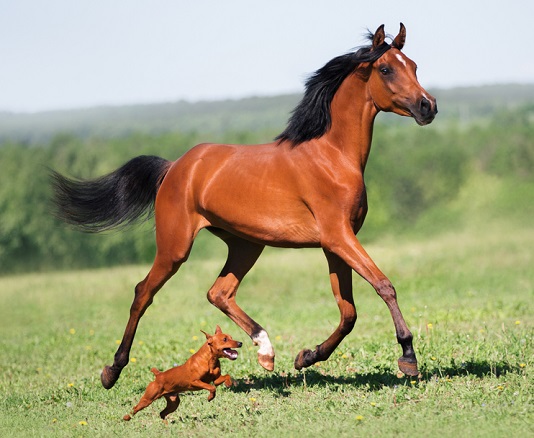
Olesya Nickolaeva / Shutterstock.com
While the breed has changed little in appearance and temperament over its history, Arabian Horses didn’t remain 100% pure.
According to a 2010 study by Iwona Głażewska, the purity of the modern Arabian can only be traced back 200 years. The study suggests that the Arabian Horse, as we know it today, is the result of widespread crossbreeding between various breeds rather than pure bloodlines.
Also Read: 6 Oldest Horse Breeds In The World
2. Most Modern Horse Breeds Have Arabian Bloodlines
Being one of the oldest breeds means that Arabian Horses have influenced many modern horse breeds. In fact, if we traced pedigrees back far enough, we would find that most breeds today have some Arabian blood running through their veins.
In the past, horse breeders all over the world used Arabian Horses to refine their current stock. Arabian blood was known to add speed, stamina, and strong bone to the recipient breed.
Horse breeds most influenced by the Arabian Horse are:
ThoroughbredAnglo-ArabianMorganAmerican SaddlebredPercheronQuarter HorseWelsh Pony and Cob
There were also several instances where Arabian crosses have become their own breed. Examples are the Quarab (Arabian x Quarter Horse), National Show Horse (Arabian x Saddlebred), Morab (Arabian x Morgan), Pintabian (Arabian x Pinto), and Welara (Arabian x Welsh Pony) horse breeds.
3. They are one of the most popular horse breeds in the world
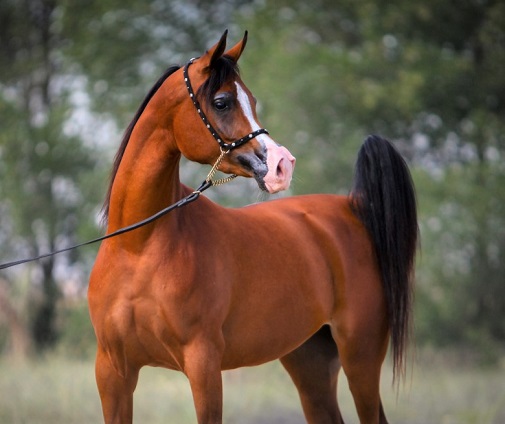
Ali Almomin / Shutterstock.com
It is no surprise that the Arabian Horse are among the most popular horse breeds in the world. Once confined to the desert lands of Saudi Arabia, they have now conquered the world with large populations living on most continents.
According to the World Arabian Horse Organization (WAHO), there were over one million Arabians living in 62 countries in 2014.
Over than half of the world’s population (663,833) resided in the United States, followed by Canada (48,010). Moreover, large numbers of Arabian Horses are found in the United Kingdom, Australia, and Brazil.
4. The Bedouin People Shared Their Homes With Arabian Horses
For thousands of years, Arabians lived among the desert tribes of the Arabia Peninsula. The tribe that originally developed the Arabian Horse breed was the Beduins. They meticulously bred the best horses and treated them as part of their families.
Traditionally, the Beduins believed that the Arabian Horse was brought to them by Allah himself. According to this origin story, Allah created the horse from the south wind, exclaiming:
“I create thee, Oh Arabian. To thy forelock, I bind Victory in battle. On thy back, I set a rich spoil and a Treasure in thy loins. I establish thee as one of the Glories of the Earth… I give thee flight without wings.” (Source: Natural Horse Planet)
The Beduin people maintained a rigorous breeding program to ensure their horses were of the purest breeding. They selectively bred for alertness, speed, and stamina, qualities that were essential in raiding and war. The Beduins regarded Arabians so highly that they even shared their tents with their horses.
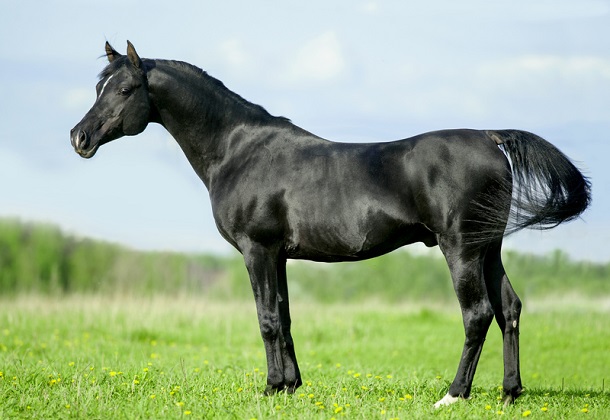
Olga_i / Shutterstock.com 5. There Are Various Types Of Arabian Horses
Although the Arabian is one uniform breed, various types of Arabian Horses developed over time. For centuries, the purest Arabian bloodlines were referred to as the “Bedouin strain”, but this is no longer the case. As several countries began their own Arabian breeding programs, many breed types bear the name of their home country.
The most popular type of Arabians today are the Egyptian, Spanish, Polish, Russian, Shagya, Domestic and Crabbet. The Shagya Arabians were developed in Hungary, while the Domestic type originates in the United States. Crabbet Arabians descent from the pure Arabian Horses of Lady Ann Blunt, who imported the horses to England.
In the US, people often referred to Arabian Horses using the name of the farm or family that bred them. This is how bloodlines like the Kellogg, Babson, and Davenport became known. (Source: arabianhorses.org)
Also see our article on the 6 Types of Purebred Arabian Horses.
6. Arabians Were Selectively Bred To Bond With Humans
In their horse breeding programs, the Bedouins purposely selected for the ability to bond with humans. Hence why the Arabians are especially cooperative and quick to form partnerships with humans.
The Bedouins also bred for other desirable traits such as intelligence, quick learning ability, and good temperament. The Arabian Horse’s outstanding beauty and qualities are the reason why so many people fall in love with this breed.
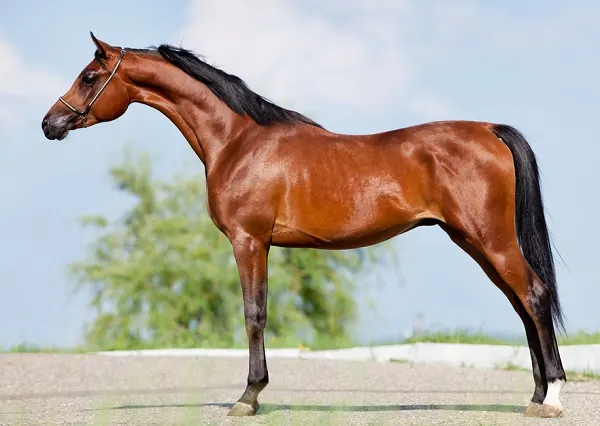
Alexia Khruscheva / Shutterstock.com 7. Arabian Horses Have Fewer Bones In Their Skeleton
The concave profile and flagging tail are not the only peculiar features of the Arabian Horse. Many also have one less lumbar vertebrae, pair of ribs, and tail bone than other horse breeds.
Most modern horses have a total of 205 bones, including 6 lumbar vertebrae, 18 pairs of ribs, and 15-25 tail bones. In contrast, many Arabian Horses only have 5 lumbar vertebrae, 17 pairs of ribs, and fewer than average tail bones. This is reflected in their appearance, as Arabians have typically shorter torsos and a shorter tail, resulting in high tail carriage.
Also Read: 40 Incredible Horse Facts You Probably DIdn’t Know
8. Gray Is The Most Common Color In The Breed
Gray horses were often favored by royals and the aristocracy in the past. As a result, nearly half of the living Arabian Horse population (402,249) is gray, according to the WAHO (2014 data). Other accepted colors are bay, chestnut, black, and roan, although the latter two are less common.
Purebred Arabians don’t carry genes for pinto or leopard spotting, with the exception of sabino. Included in our rarest horse coat colors guide, Sabino horses usually have white legs and irregular while markings and roaning on the body.
Pure Arabians also can’t be of any dilution color, such as palomino, dun, buckskin, or cremello. Any Arabians you might have seen with these colors had to be crossbred at some point in their breeding.
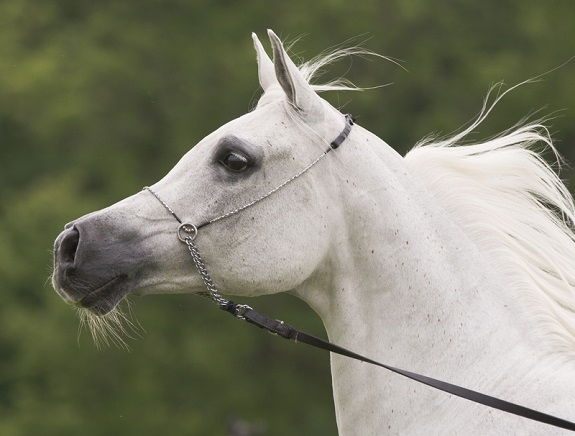
Sara Julin Ingelmark / Shutterstock.com
All Arabian Horses have black skin under their coats, which was essential for surviving under the desert sun. The only exception is horses with the rare dominant white coloring, meaning their skin has no pigment cells. The skin under white markings such as a star or blaze is also pink.
9. Many Famous People Throughout History Have Owned Arabians
The speed, agility, and fierce spirit of Arabians have made them a desirable and formidable war mount. Many of the most famous horses in history rode by George Washington, Napoleon Bonaparte, Ghengis Khan, and Alexander the Great were Arabian horses.
General George Washington rode his famous half-Arabian horse Blueskin during the American Revolution. He was among the first to import Arabian Horses to the United States, with the purpose of creating a faster and stronger cavalry mount.
Celebrities have also fallen in love with these gorgeous horses. Mentioned in our celebrity horse lovers guide, Patrick Swayze was an avid lover of the breed and owned, as well as showed, many Arabian Horses. Country music star Shania Twain also owns a beautiful bay Arabian gelding.
Also Read: 8 Most Famous Arabian Horses in History
10. Arabian Horses Dominate Endurance Riding
When it comes to endurance riding, few horse breeds can equal the performance of the Arabian Horse. Thousands of years in the desert has increased the lung capacity in the breed, which is vital for endurance.
Arabians also have a higher proportion of slow-twitch muscle fibers than other horse breeds. This allows them to use oxygen more efficiently and sustain speed over long distances. It is no wonder therefore that the champions of the world’s toughest endurance races have consistently been Arabians.
One of the most legendary endurance horses was the Arabian stallion Shahzada. Born in Great Britain in 1913, he won two 300-mile endurance races, carrying a total load of 13½ stone.
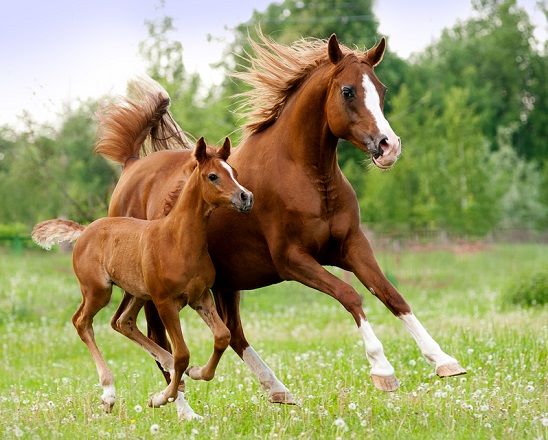
Olga_i / Shutterstock.com
To immortalize his remarkable victory, the world’s longest endurance race is now called The Shahzada Memorial Endurance Test.
The race stretches across 400 kilometers (250 miles) and is held each year at St. Albans, New South Wales, Australia. Another renowned endurance event is the Tevis Cup, where riders must complete a 100-mile (160 km) route in a day. Endurance is also one of the eight disciplines of the World Equestrian Games.
11. Arabian Horses Are Extremely Versatile
Arabian Horses are one of the most versatile horse breeds in the world, which is also the main reason for their popularity.
Besides endurance, these fiery horses will excel at almost every discipline they are put to. Whether you want to do English or Western riding or Natural Horsemanship, you have found a horse for life.
As mentioned previously, not all Arabians are the same. Depending on their type and bloodlines, Arabians can vary somewhat in appearance and talent.
Some horses have broader, muscular hindquarters ideal for performing explosive bursts of speed. These types of Arabians are most suitable for Western disciplines, especially reining, cutting, and western pleasure. They also make great working ranch horses.
Other Arabians are leaner and better muscled for endurance or flat racing. The breed has also excelled in classical disciplines like dressage, show jumping, and eventing. Due to their adaptability and friendly nature, Arabians are also ideal as trail riding, pleasure, or family horses.
But that’s not all. Arabian Horses have also served as the mounts of police and rescue forces, polo players, and circus performers. They have proven their worth in therapeutic riding and combined driving. To put it simply, there’s just nothing these brave little horses won’t do.

cynoclub / Shutterstock.com
Also Read: Meet Majus and Majician: Twin Arabian Horses That Defied Odds
12. There are Arabian Horse Races
Riders have raced Arabian Horses against each other since the early days of the breed. It’s a thrilling experience to watch these graceful horses run at breakneck speed, so it’s no wonder the sport has persisted into modern times.
The Arabian Jockey Club has held races across the United States since 1959 to showcase the speed of the amazing Arabian breed. More than 700 breed-specific races run in the country each year, at an average distance of 6 furlongs.
The largest event in the Arabian horse racing industry is undoubtedly the Arabian Cup Championship, held annually at Delaware Park, United States. It attracts the best Arabian racehorses in the nation for a weekend of racing. The Cup consists of six races, with a total prize of $400,000.
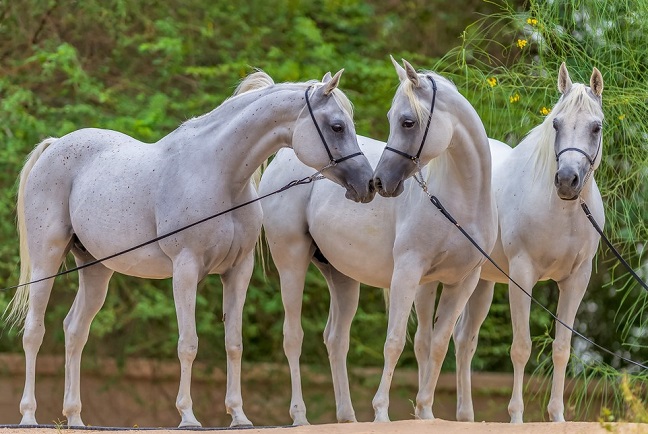
HAMAD DNDRN / Shutterstock.com
Arabians as racehorses are becoming more and more popular in the United States. They are not only talented runners, but also a relatively inexpensive investment.
You can buy an Arabian racehorse for $5,000 – $20,000, which hardly compares to the astronomical prices of Thoroughbred racehorses.
13. Arabians Are Popular In Literature And Film
The majestic Arabians have inspired artists and creative minds since the beginning of times. Spirited and brave, they are featured in countless poems, stories, and novels.
The movie industry was also quick to embrace the beauty and nobility of the breed. As early as 1926, Rudolph Valentino rode a Kellog Arabian Stallion called Jadaan in the silent film Son of the Sheik. More recent movies featuring Arabian Horses include The Black Stallion (1979), The Young Black Stallion (2003), and Hidalgo (2004).
Also Read: 17 Famous Horses from Movies and TV Series
Source: horseyhooves.com








